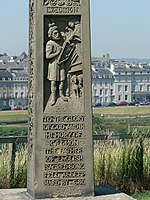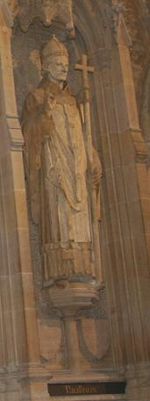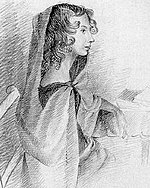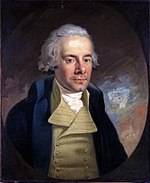Portal:Yorkshire/Selected biography
Portal:Yorkshire/Selected biography/1

Shaun Mark Bean (born 17 April 1959) is an English film and stage actor. Bean has also acted in a number of television productions as well as performing voice work for computer games and television adverts. Bean was born Shaun Mark Bean in the Handsworth district of Sheffield, South Yorkshire, England, the son of Rita and Brian Bean. As an actor, he adopted the Celtic spelling "Sean" of his first name. Bean has played a wide range of roles, from villains to heroes. He graduated from RADA in 1983 having won the Silver Medal for his performance in Waiting for Godot. His first successful role was his portrayal of Richard Sharpe in the United Kingdom television series Sharpe. Since then he has become well known internationally for his roles as Boromir in The Lord of the Rings, Martin Septim in The Elder Scrolls IV: Oblivion video game, James Bond's adversary Alec Trevelyan in GoldenEye, Nicolas Cage's competitor Ian Howe in National Treasure, IRA fringe terrorist Sean Miller out for revenge on Harrison Ford in Patriot Games, Captain Rich in Flightplan with Jodie Foster, and Odysseus in Troy. (read more . . . )
Portal:Yorkshire/Selected biography/2

Caedmon /ˈkædmɒn/ is the earliest English poet whose name is known. An Anglo-Saxon herdsman attached to the double monastery of Streonæshalch (Whitby Abbey) during the abbacy of St. Hilda (657–680), he was originally ignorant of "the art of song" but according to Bede learned to compose one night in the course of a dream. He later became a zealous monk and an accomplished and inspirational religious poet. Caedmon is one of twelve Anglo-Saxon poets identified in medieval sources, and one of only three for whom both roughly contemporary biographical information and examples of literary output have survived. His story is related in the Historia ecclesiastica gentis Anglorum ("Ecclesiastical History of the English People") by St. Bede who wrote, "[t]here was in the Monastery of this Abbess a certain brother particularly remarkable for the Grace of God, who was wont to make religious verses, so that whatever was interpreted to him out of scripture, he soon after put the same into poetical expressions of much sweetness and humility in English, which was his native language. By his verse the minds of many were often excited to despise the world, and to aspire to heaven." (read more . . . )
Portal:Yorkshire/Selected biography/3

Paulinus (died 10 October 644) was a Roman missionary and the first Bishop of York. A member of the Gregorian mission sent in 601 by Pope Gregory I to Christianize the Anglo-Saxons from their native Anglo-Saxon paganism, Paulinus arrived in England by 604 with the second missionary group. Little is known of Paulinus' activities in the following two decades.
After some years spent in Kent, perhaps in 625, Paulinus was consecrated a bishop. He accompanied Æthelburg of Kent, sister of King Eadbald of Kent, on her journey to Northumbria to marry King Edwin of Northumbria, and eventually succeeded in converting Edwin to Christianity. Paulinus also converted many of Edwin's subjects and built some churches. One of the women Paulinus baptised was a future saint, Hilda of Whitby. Following Edwin's death in 633, Paulinus and Æthelburg fled Northumbria, leaving behind a member of Paulinus' clergy, James the Deacon. Paulinus returned to Kent, where he became Bishop of Rochester. After his death in 644, Paulinus was venerated as a saint. (read more . . . )
Portal:Yorkshire/Selected biography/4

Sir Henry Spencer Moore OM CH FBA, (30 July 1898 – 31 August 1986) was an English artist and sculptor. The son of a mining engineer, born in the Yorkshire town of Castleford, Moore became well known for his larger-scale abstract cast bronze and carved marble sculptures. Substantially supported by the British art establishment, Moore helped to introduce a particular form of modernism into the United Kingdom.
Moore is best known for his abstract monumental bronzes which can be seen in many places around the world as public works of art. The subjects are usually abstractions of the human figure, typically mother-and-child or reclining figures. Apart from a flirtation with family groups in the 1950s, the subject is nearly always a woman. Characteristically, Moore's figures are pierced, or contain hollow places. Many interpret the undulating form of his reclining figures as references to the landscape and hills of Yorkshire where Moore was born.
His ability to satisfy large-scale commissions made him exceptionally wealthy towards the end of his life. However, he lived frugally and most of his wealth went to endow the Henry Moore Foundation, which continues to support education and promotion of the arts. (read more . . . )
Portal:Yorkshire/Selected biography/5

Anne Brontë /ˈbrɒnti/ (17 January 1820 – 28 May 1849) was a British novelist and poet, the youngest member of the Brontë literary family. Anne Brontë lived most of her life with her family at the remote village of Haworth on the Yorkshire moors. For a couple of years she went to a boarding school. At the age of nineteen, she left Haworth working as a governess between 1839 and 1845. After leaving her teaching position, she fulfilled her literary ambitions. She wrote a volume of poetry with her sisters (Poems by Currer, Ellis and Acton Bell, 1846) and in short succession she wrote two novels: Agnes Grey, based upon her experiences as a governess, was published in 1847; her second and last novel, The Tenant of Wildfell Hall appeared in 1848. Anne's creative life was cut short with her death of pulmonary tuberculosis when she was only twenty-nine years old. Anne's two novels, written in a sharp and ironic style, are completely different from the romanticism followed by her sisters. She wrote in a realistic, rather than a romantic style. Her novels, like those of her sisters, have become classics of English literature. (read more . . . )
Portal:Yorkshire/Selected biography/6

Patrick Hewes Stewart, OBE (born 13 July 1940) is an Emmy and Golden Globe-nominated English film, television and stage actor. He born in Mirfield, West Yorkshire, England is Chancellor of the University of Huddersfield. Stewart has had a distinguished career in theatre for nearly fifty years, including performances as various characters in Shakespearean productions. However, he is perhaps most widely known for his roles as Captain Jean-Luc Picard of the starship Enterprise in Star Trek: The Next Generation, and as Professor Xavier in the X-Men films. Following a period with the Manchester Library Theatre, he joined the Royal Shakespeare Company (RSC) in 1966 where he appeared next to actors such as Ben Kingsley and Ian Richardson. He made his Broadway debut as Snout in Peter Brook's legendary production of A Midsummer Night's Dream, then moved to the Royal National Theatre in the early 1980s. Over the years, Stewart took roles in many major television series without ever becoming a household name. He appeared as Lenin in Fall of Eagles; Sejanus in I, Claudius; Karla in Tinker, Tailor, Soldier, Spy and Smiley's People; Claudius in a 1980 BBC adaptation of Hamlet. (read more . . . )
Portal:Yorkshire/Selected biography/7

Captain James Cook FRS RN (27 October 1728 (O.S.) – 14 February 1779) was an English explorer, navigator and cartographer born in Marton in North Yorkshire. Ultimately rising to the rank of Captain in the Royal Navy, Cook was the first to map Newfoundland prior to making three voyages to the Pacific Ocean during which he achieved the first European contact with the eastern coastline of Australia and the Hawaiian Islands as well as the first recorded circumnavigation of New Zealand. Cook joined the British merchant navy as a teenager, and joined the Royal Navy in 1755. He saw action in the Seven Years' War, and subsequently surveyed and mapped much of the entrance to the St. Lawrence River during the siege of Quebec. This allowed General Wolfe to make his famous stealth attack on the Plains of Abraham, and helped to bring Cook to the attention of the Admiralty and Royal Society. This notice came at a crucial moment both in his personal career and in the direction of British overseas exploration, and led to his commission in 1766 as commander of HM Bark Endeavour for the first of three Pacific voyages. (read more . . . )
Portal:Yorkshire/Selected biography/8

Dame Judith Olivia Dench, CH, DBE, FRSA, (born 9 December 1934), usually known as Dame Judi Dench, is an Academy Award-, Golden Globe-, Tony-, three-time BAFTA-, and six-time Laurence Olivier Award-winning English actress. Dench was born in York, North Yorkshire, England, the daughter of Eleanora Olave (née Jones), who was Irish and a native of Dublin, and Reginald Arthur Dench, a doctor who met Dench's mother while studying medicine at Trinity College. Dench's more recent film career has been extremely successful. She successfully garnered six Oscar nominations in nine years for Mrs Brown in 1997; her Oscar-winning turn in Shakespeare in Love in 1998; for Chocolat in 2000; for the lead role of writer Iris Murdoch in Iris in 2001 (with Kate Winslet playing her as a younger woman); for Mrs Henderson Presents (a romanticised history of the Windmill Theatre) in 2005; and for 2006's Notes on a Scandal, a film for which she received critical acclaim, including Golden Globe and Screen Actors Guild nominations. In February 2008, she was named as the first official patron of the York Youth Mysteries 2008, a project to allow young people to explore the York Mystery Plays through dance, film-making and circus. (read more . . . )
Portal:Yorkshire/Selected biography/9

Saint Edwin (alternately Eadwine or Æduini) (c. 586–12 October 632/633) was the King of Deira and Bernicia - which would later become known as Northumbria - from about 616 until his death. He converted to Christianity and in 627 was baptised in York; after he fell at the Battle of Hatfield Chase, he was venerated as a saint. Edwin was the son of Ælle king of Deira. His sister Acha was married to Æthelfrith, king of neighbouring Bernicia. An otherwise unknown sibling fathered Hereric, who in turn fathered Abbess Hilda of Whitby and Hereswith, wife to king Anna of East Anglia's brother Æthelric. With the death of Æthelfrith, and of the powerful Æthelberht of Kent the same year, Raedwald and his client Edwin were well placed to dominate England, and indeed Raedwald did so until his death a decade later. Edwin annexed the minor British kingdom of Elmet following a campaign in either 616 or 626. Elmet had probably been subject to Mercia and then to Edwin. The much larger kingdom of Lindsey appears to have been taken over c. 625, after the death of king Raedwald. (read more . . . )
Portal:Yorkshire/Selected biography/10

Joseph Priestley (13 March 1733 (old style) – 6 February 1804) was an 18th-century British theologian, Dissenting clergyman, natural philosopher, educator, and political theorist who published over 150 works. He is usually credited with the discovery of oxygen gas. Priestley was born to an established Dissenting family in West Yorkshire.
During his lifetime, Priestley's considerable scientific reputation rested on his invention of soda water, his writings on electricity, and his discovery of several "airs" (gases), the most famous being what Priestley dubbed "dephlogisticated air" (oxygen). However, Priestley's determination to reject what would become the chemical revolution and to cling to phlogiston theory eventually left him isolated within the scientific community.
Priestley's science was integral to his theology, and he consistently tried to fuse Enlightenment rationalism with Christian theism. In his metaphysical texts, Priestley attempted to combine theism, materialism, and determinism, a project that has been called "audacious and original". He believed that a proper understanding of the natural world would promote human progress and eventually bring about the Christian Millennium. Priestley, who strongly believed in the free and open exchange of ideas, advocated toleration and equal rights for religious Dissenters, which also led him to help found Unitarianism. (read more . . . )
Portal:Yorkshire/Selected biography/11

William Wilberforce (24 August 1759 – 29 July 1833) was a British politician, philanthropist and a leader of the movement to abolish the slave trade. A native of Hull, Yorkshire, he began his political career in 1780 and became the independent Member of Parliament for Yorkshire (1784–1812) and a close friend of Prime Minister William Pitt the Younger. In 1785 he underwent a conversion experience and became an evangelical Christian, resulting in changes in his lifestyle and in his interest in reform. In 1787 he came into contact with Thomas Clarkson and a group of anti-slave trade activists, including Granville Sharp, Hannah More and Lord Middleton. They persuaded Wilberforce to take on the cause of abolition; and he soon became one of the leading English abolitionists, heading the parliamentary campaign against the British slave trade until the eventual passage of the Slave Trade Act in 1807. Wilberforce died just three days after hearing that the passage of the Act through Parliament was secure. He was buried in Westminster Abbey, close to his friend William Pitt. (read more . . . )
Portal:Yorkshire/Selected biography/12
Saint William of York, (d. 1154) also known as William FitzHerbert, William I FitzHerbert and William of Thwayt, was an English priest and Archbishop of York. FitzHerbert is unusual in having been Archbishop of York twice, both before and after his rival Henry Murdac. He was a relative of King Stephen of England, and the king helped secure FitzHerbert's election to York after a number of candidates had failed to secure papal confirmation. FitzHerbert faced opposition from the Cistercians who, after the election of the Cistercian Pope Eugenius III, managed to have the archbishop deposed in favor of the Cistercian Murdac. From 1147 until 1153, FitzHerbert worked to secure his restoration to York, which he finally achieved after the deaths of both Murdac and Eugenius. He did not retain the see long, as he died shortly after returning to York, allegedly having been poisoned. After his death miracles were reported at his tomb, and in 1227 he was declared a saint. (read more . . . )
Portal:Yorkshire/Selected biography/13

Guy Fawkes (13 April 1570 – 31 January 1606), also known as Guido Fawkes, the name he adopted while fighting for the Spanish in the Low Countries, belonged to a group of provincial English Catholics who planned the failed Gunpowder Plot of 1605.
Fawkes was born and educated in York. His father died when Fawkes was aged eight, after which his mother married a recusant Catholic. Fawkes later converted to Catholicism and left for the continent, where he fought in the Eighty Years' War on the side of Catholic Spain against Protestant Dutch rebels. He travelled to Spain to seek support for a Catholic rebellion in England but was unsuccessful. He later met Thomas Wintour, with whom he returned to England.
Wintour introduced Fawkes to Robert Catesby, who planned to assassinate King James I and restore a Catholic monarch to the throne. The plotters secured the lease to an undercroft beneath the House of Lords, and Fawkes was placed in charge of the gunpowder they stockpiled there. Prompted by the receipt of an anonymous letter, the authorities searched Westminster Palace during the early hours of 5 November, and found Fawkes guarding the explosives. Over the next few days, he was questioned and tortured, and eventually he broke. Immediately before his execution on 31 January, Fawkes jumped from the scaffold where he was to be hanged and broke his neck, thus avoiding the agony of the drawing and quartering that followed.
Fawkes became synonymous with the Gunpowder Plot, which has been commemorated in England since 5 November 1605. His effigy is burned on a bonfire, often accompanied by a firework display. (read more . . . )
Portal:Yorkshire/Selected biography/14
George Gibson Macaulay (7 December, 1897 – 13 December, 1940), was a professional English cricketer who played first-class cricket for Yorkshire County Cricket Club between 1920 and 1935. He played in eight Test matches for England from 1923 to 1933, achieving the rare feat of taking a wicket with his first ball in Test cricket. One of the five Wisden Cricketers of the Year in 1924, he took 1,838 first-class wickets at an average of 17.64 including four hat-tricks.
A leading member of the Yorkshire team which achieved a high level of success in the time he played, Macaulay was a volatile character who played aggressively. He left a job at a bank to become a professional cricketer, making his first-class debut aged 23 as a fast bowler. Meeting limited success, he altered style to deliver off spin in addition to his pace bowling. This proved so effective that he was chosen to play for England in Test matches. However, his perceived poor attitude towards the game, and an unsuccessful match in the 1926 Ashes probably prevented him playing more Tests. His form slumped following injuries in the late 1920s, but a recovery in the early 1930s led to a recall by England, although he broke down in his second match back. Another injury in 1934 made cricket difficult for him and his first-class career ended in 1935, although he continued playing club cricket until the Second World War. A pilot officer in the Royal Air Force, he died of illness on active service in the Second World War. (read more . . . )
Portal:Yorkshire/Selected biography/15

George Herbert Hirst (7 September 1871 – 10 May 1954) was a professional English cricketer who played first-class cricket for Yorkshire County Cricket Club between 1891 and 1921, with a further appearance in 1929. He played in 24 Test matches for England between 1897 to 1909, touring Australia twice. One of the best all-rounders of his time, Hirst was a left arm medium-fast bowler and right-handed batsman. He completed the double of 1,000 runs and 100 wickets in an English cricket season 14 times, the second most of any cricketer after his contemporary and team-mate Wilfred Rhodes. One of the Wisden Cricketers of the Year for 1901, Hirst scored 36,356 runs and took 2,742 wickets in first-class cricket. His Test figures were 790 runs and 59 wickets. (read more . . . )
Portal:Yorkshire/Selected biography/16
Gerard (died 21 May 1108) was Archbishop of York between 1100 and 1108 and Lord Chancellor of England from 1085 until 1092. A Norman, he was a member of the cathedral clergy at Rouen before becoming a royal clerk under King William I of England and subsequently his son King William II Rufus. Gerard was appointed Lord Chancellor by William I, and he continued in that office under Rufus, who rewarded him with the Bishopric of Hereford in 1096. Gerard may have been with the king's hunting party when William II was killed, as he is known to have witnessed the first charter issued by the new king, Henry I of England, within days of William's death.
Soon after Henry's coronation Gerard was appointed to the recently vacant see of York, and became embroiled in the long-running dispute between York and the see of Canterbury concerning which archbishopric had primacy over England. Gerard managed to secure papal recognition of York's claim to jurisdiction over the church in Scotland, but he was forced to agree to a compromise with his counterpart at Canterbury, Anselm, over Canterbury's claims to authority over York, although it was not binding on his successors. In the Investiture Controversy between the king and the papacy over the right to appoint bishops, Gerard worked on reconciling the claims of the two parties; the controversy was finally resolved in 1107.
Gerard was a patron of learning, to the extent that he urged at least one of his clergy to study Hebrew, a language not commonly studied at that time. He himself was a student of astrology, which led to suggestions that he was a magician and a sorcerer. Partly because of such rumours, and his unpopular attempts to reform his cathedral clergy, Gerard was denied a burial inside York Minster after his sudden death in 1108. His successor as archbishop subsequently had Gerard's remains moved into the cathedral church from their initial resting place beside the cathedral porch.
Portal:Yorkshire/Selected biography/17
Geoffrey (sometimes Geoffrey Plantagenet, Geoffrey fitzPlantagenet, or Geoffrey fitzRoy; c. 1152 – 12 December 1212) was an illegitimate son of Henry II, King of England, who became Bishop-elect of Lincoln and Archbishop of York. The identity of his mother is uncertain, but she may have been named Ykenai. Geoffrey held a number of minor clerical offices before becoming Bishop of Lincoln in 1173, although he was not ordained a priest until 1189. In 1173–1174 he led a campaign in the north of England to help put down a rebellion by his legitimate half-brothers; this campaign led to the capture of the King of Scots. By 1182 Pope Lucius III had ordered that Geoffrey either resign Lincoln or be consecrated; he chose to resign, and became Chancellor instead. He was the only one of Henry II's sons present at the king's death.
Geoffrey's half-brother Richard I, also known as "Richard Lionheart", nominated him Archbishop of York after succeeding to the throne of England, probably to force him to become a priest and thus eliminate a potential rival for the throne. After some dispute Geoffrey was consecrated archbishop in 1191. He soon became embroiled in a conflict with William Longchamp, Richard's regent in England, after being detained at Dover on his return to England following his consecration in France. Geoffrey claimed sanctuary in the town, but he was seized by agents of Longchamp and briefly imprisoned in Dover Castle. Subsequently a council of magnates ordered Longchamp out of office, and Geoffrey was able to proceed to his archdiocese. The archbishop spent much of his archiepiscopate in various disputes with his half-brothers: first Richard and then John, Richard's successor to the English throne in 1199. Geoffrey also quarrelled with his suffragan bishops, his cathedral chapter, and other clergy in his diocese. His last quarrel with John was in 1207, when the archbishop refused to allow the collection of a tax and was driven into exile in France, where he died five years later.
Portal:Yorkshire/Selected biography/18

Hedley Verity (18 May 1905 – 31 July 1943) was a professional cricketer who played for Yorkshire and England between 1930 and 1939. A slow left-arm orthodox bowler, he took 1,956 wickets in first-class cricket at an average of 14.90 and 144 wickets in 40 Tests at an average of 24.37. Named as one of the Wisden Cricketers of the Year in 1932, he is regarded as one of the most effective slow left-arm bowlers to have played cricket. Never someone who spun the ball sharply, he achieved success through the accuracy of his bowling. On pitches which made batting difficult, particularly ones affected by rain, he could be almost impossible to bat against. (read more . . . )
Portal:Yorkshire/Selected biography/19
Portal:Yorkshire/Selected biography/19
